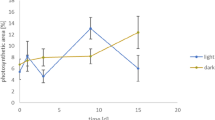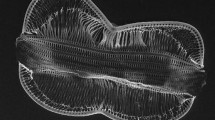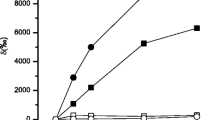Abstract
A method is described for studying the release of soluble organic material during photosynthesis by benthic algae. The method simulates presumed natural conditions in that the excreted matter is rapidly and continuously removed. This also facilitates analysis of the soluble compounds and the study of factors affecting excretion. Axenic cultures ofPhaeodactylum tricornutum (Bohlin) of good photosynthetic activity, as determined by measurement of oxygen output, were exposed as a surface layer to labelled carbon dioxide in a perspex fixation cell. Deep culture experiments also involved rapid separation of excreted solutes. Levels of excretion of 1 to 3% of total fixation were found. Some of the excreted material had been inside the cell for some hours. The proportion of fixed carbon excreted was similar in old and fresh media and was not affected by the presence of buffer. Co-precipitation with iron and copper was successful in extracting the labelled solutes from the filtrates, but the specific activity was too low to permit complete identification. There appeared to be differences between the materials excreted in surface and in deep culture. A discussion of related studies leads to a suggestion that it may be useful to consider the released solutes as falling into two categories; the first a low but constant level of excretion of more complex compounds, and the second a potentially much higher but variable level of excretion of simpler compounds.
Similar content being viewed by others
Literature cited
Aleem, A. A.: The diatom community inhabiting the mud-flats at Whitstable. New Phytol.49, 174–188 (1950).
Aleyev, B. S.: Secretion of organic substances by algae into the surrounding medium. Mikrobiologiya3, 506–508 (1934).
Allen, M. B.: Excretion of organic compounds byChlamydomonas. Arch. Mikrobiol.24, 163–168 (1956).
Antia, N. J., C. D. McAllister, T. R. Parsons, K. Stephens andJ. D. H. Strickland: Further measurements of primary production using a large-volume plastic sphere. Limnol. Oceanogr.8, 166–183 (1963).
Armstrong, F. A. J. andG. T. Boalch: Volatile organic matter in algal culture media and sea water. Nature, Lond.185, 761–762 (1960).
Basham, J. A. andM. Kirk: The effect of oxygen on the reduction of carbon dioxide to glycolic acid and other products during photosynthesis byChorella. Biochem. biophys. Res. Commun.9, 376–380 (1962)
Belmont, L. andJ. D. A. Miller: Utilization of glutamine by algae J. exp. Bot.16, 318–324 (1965)
Blaauw-Jansen, G.: Chlorophyllide, the probable precursor of a growth inhibitor. Nature, Lond.174, 312–313 (1954).
Braarud, T. andB. Føyn: Beiträge zur Kenntnis des Stoffwechsels in Meere. Avh. norske Videns-Akad Oslo (Mat. Naturv. Kl.).14 1–24 (1930).
Brafield, A. E.: The oxygen content of interstitial water in sandy shores. J. Anim. Ecol.33, 97–116 (1964).
Calvin, M., J. A. Bassham, A. A. Benson, V. H. Lynch, C. Ouellet, L. Schou, W. Stepka andN. E. Tolbert: Carbon dioxide assimilation in plants. Symp. Soc. exp. Biol.5, 284–305 (1951).
Chapman, G. andA. C. Rae: Isolation of organic solutes from sea water by co-precipitation. Nature, Lond.214, 627–628 (1967).
— andA. G. Taylor: Uptake of organic solutes byNereis virens. Nature, Lond.217, 763–764 (1968).
Chipperfield, J. R.: The kinetics of combination of carbon dioxide with the anions of glycine, glycyl-glycine and related amino acids. Proc. R. Soc. (B)164, 401–410 (1966).
Collins, R. P. andG. H. Bean: Volatile constituents obtained fromChlamydomonas globosa. I. The carboxyl fraction. Physologia3, 55–59 (1963).
Coombs, J. andC. P. Whittingham: The mechanism of inhibition of photosynthesis by high partial pressures of oxygen inChlorella. Proc. R. Soc. (B.)164, 511–520 (1966).
Cooper, L. H. N.: Chemistry of the sea. 2. Organic. Chemy Britain1, 150–154 (1965).
Craigie, J. S. andJ. McLachlan: Excretion of coloured ultraviolet-absorbing substances by marine algae. Can. J. Bot.42, 23–33 (1964).
Droop, M. R.: Requirements for thiamine among some marine and supralittoral Protista. J. mar. biol. Ass. U.K.37, 323–329 (1958).
—: Organic acids and bases and the lag phase inNannochloris oculata. J. mar. biol. Ass. U.K.46, 673–678 (1966).
Duursma, E. K. andW. Sevenhuysen: Note on chelation and solubility of certain metals in sea water at different pH values. Neth. J. Sea Res.3, 95–106 (1966).
Ferguson, J. C.: An autoradiographic study of the utilization of free exogenous amino acids by starfishes. Biol. Bull. mar. biol. Lab., Woods Hole133, 317–329 (1967).
Fogg, G. E.: The Extacellular products of algae. Oceanogr. mar. Biol. A. Rev.4, 195–212 (1966).
— andG. T. Boalch: Extracellular products in pure cultures of a brown alga. Nature, Lond.181, 789–790 (1958).
—,C. Nalewajko andW. D. Watt: Extracellular products of phytoplankton photosynthesis. Proc. R. Soc. (B.)162, 517–534 (1965).
— andD. F. Westlake: The importance of Extacellular products of algae in freshwater. Verb. int. Verein. theor. angew. Limnol.12, 219–232 (1965).
Gran, H. H.: On the conditions for the production of plankton in the sea. Rapp. P.-v. Réun. Cons. perm. int. Explor. Mer.75, 37–46 (1931).
Gross, F.: The life history of some marine plankton diatoms. Phil. Trans. R. Soc. (B.)228, 1–47 (1937).
Guillard, R. R. L. andP. J. Wangersky: The production of extracellular carbohydrates by some marine flagellates. Limnol. Oceanogr.3, 449–454 (1958).
Hallmann, M. andJ. Mager: An endogenously produced substance essential for growth initiation ofPasteurella tularensis. J. Ken. Microbiol.49, 461–468 (1967).
Hamilton, R. D. andL. J. Greenfield: The utilisation of free amino acids by marine sediment microbiota. Z. allg. Mikrobiol.7, 335–342 (1967).
Hellebust, J. A.: Excretion of some organic compounds by marine phytoplankton. Limnol. Oceanogr.10, 192–206 (1965).
Hoffmann, L. R.: Chemotaxis ofOedogonium sperms. SWest. Nat.5, 111–116 (1960).
Hopkins, J. T.: A study of the diatoms of the Ouse estuary Sussex. III. The seasonal variation in the littoral epiphyte flora and the shore plankton. J. mar. biol. Ass. U.K.44, 613–644 (1964).
Jørgensen, E. G.: Antibiotic substances from cells and culture solutions of unicellular algae with special reference to some chlorophyll derivatives. Physiologia Pl.15, 530–545 (1962).
Kalle, K.: The problem of the Gelbstoff in the sea. Oceanogr. mar. Biol. A. Rev.4, 91–104 (1966).
Katayama, T.: Volatile constituents.In: Physiology and biochemistry of the algae, pp 467–473. Ed. byR. A. Lewin. New York: Academic Press 1962.
Krogh, A.: Über die Bedeutung yon gelösten organischen Substanzen bei der Ernährung yon Wassertieren. Z. vergl. Physiol.12, 668–681 (1930).
—,E. Lange andW. Smith: The organic matter given off by algae. Biochem. J.24, 1666–1667 (1930).
Lange, W.: Effect of carbohydrate on the symbiotic growth of planktonic blue-green algae with bacteria. Nature, Lond.215, 1277–1278 (1967).
Lewin, J. C. andR. R. L. Guillard: Diatoms. A. Rev. Microbiol.17, 373–414 (1963).
Lewin, R. A.: Extracellular polysaccharides of green algae. Can. J. Microbiol.2, 665–672 (1956).
Little, C. andB. L. Gupta: Pogonophora; uptake of dissolved nutrients. Nature, Lond.218, 873–874 (1968).
Lund, J. W. G.: Primary production and periodicity of plankton algae. Verh. int. Verein. theor. angew. Limnol.15, 37–56 (1964).
—: The ecology of the freshwater phytoplankton. Biol. Rev.40, 231–293 (1965).
Margalef, R.: Succession in marine populations. Advancing Frontiers. Pl. Sci., New Delhi2, 137–188 (1962).
—: Some concepts relative to the organisation of plankton. Oceanogr. mar. Biel. A. Rev.5, 257–289 (1967).
Marker, A. F. H.: Extracellular carbohydrate liberation in the flagellatesIsochrysis galbana andPrymnesium parvum. J. mar. biol. Ass. U.K.45, 755–772 (1965).
McCully, M. E.: Histological studies on the genusFucus. III. Fine structure and possible functions of the epidermal cells of the vegetative thallus. J. Cell Sci.3, 1–16 (1968).
McLachlan, J. andJ. S. Craigie: Algal inhibition by yellow ultraviolet-absorbing substances fromFucus vesiculosis. Can. J. Bot.42, 287–292 (1964).
Miller, R. M., C. M. Meyer andH. A. Tanner: Glycolate excretion and uptake byChlorella. Pl. Physiol., Lancaster38, 184–188 (1963).
Muscatine, L.: Glycerol excretion by symbiotic algae from corals andTridacna and its control by the host. Science, N.Y.156, 516–519 (1967).
Nalewajko, C.: Photosynthesis and excretion in various planktonic algae. Limnol. Oceanogr.11, 1–10 (1966).
Nordli, E.: Algal flour extract as a stimulating agent for marine dinofiagellate cultures. Nytt Mag. Bot.5, 13–16 (1957).
North, B. B. andG. C. Stephens: Uptake and assimilation of amino acids byPlatymonas. Biol. Bull. mar. biol. Lab., Woods Hole133, 391–400 (1967).
Ogata, E.: Photosynthesis inPorphyra tenera and some other marine algae as affected by tris(hydroxymethylaminomethane) in artificial media. Bot. Mag., Tokyo79, 271–282 (1966).
Overreck, J. andH. D. Babenzien: Detection of free phosphatase, amylase and saccharase in water in ponds. Naturwissenschaften50, 571–572 (1963).
Palmer, J. D. andF. E. Round: Persistent, vertical-migration rhythms in benthic microflora. I. The effect of light and temperature on the rhythmic behaviour ofEuglena obtusa. J. mar. biol. Ass. U.K.45, 567–582 (1965).
— and —: Persistent, vertical-migration rhythms in benthic microflora. VI. The tidal and diurnal nature of the rhythm in the diatomHantzschia virgata. Biol. Bull. mar. biol. Lab., Woods Hole132, 44–55 (1967).
Plamondon, J. E. andJ. A. Bassham: Glycolic acid labelling during photosynthesis with carbon dioxide —14C and tritiated water. Pl. Physiol., Lancaster41, 1272–1275 (1966).
Pratt, R.: Studies onChlorella vulgaris. XI. Relation between surface tension and accumulation of chlorellin. Am. J. Bot.35, 634–637 (1948).
—,T. C. Daniels, J. J. Eiler, J. B. Gunnison, W. D. Kummler, J. F. Oneto, H. A. Spoehr, G. J. Hardin, H. W. Miller, J. H. C. Smith andH. H. Strain: Chlorellin, an antibacterial substance fromChlorella. Science, N.Y.99, 351–352 (1944).
Pringsheim, E. G.: Über farblose Diatomeen. Arch. blikrobiol.16, 18–27 (1951).
Pütter, A.: Die Ernährung der Wassertiere and der Stoffhaushalt der Gewäasser, 172 pp. Jena: Fischer (1909).
Riley, G. A., P. J. Wangersky andD. van Hemert: Organic aggregates in tropical and sub-tropical surface waters on the North Atlantic ocean. Limnol. Oceanogr.9, 546–550 (1964).
Roughton, F. J. W. andL. Rossi-Bernardi: The carbamate reaction of carbon dioxide with glycylglycine. Proc. R. Soo. (B)164, 381–400 (1966).
Royce, A. andC. Bowler: An indicator control device for ethylene oxide sterilisation. J. Pharm. Pharmac. (Supp1.11) 294T-298T (1959).
Smayda, T. J.: Succession of phytoplaukton and the ocean as an holocoenotic environment.In: Symposium on marine microbiology, pp 260–274. Ed. byC. H. Oppenheimer. Springfield, Ill.: Thomas 1963.
Spoehr, H. A., J. C. Smith, H. H. Strain, H. W. Miller andG. J. Hardin: Fatty acid antibacterials from plants. Publs. Carnegie Instn No. 586, 67 (1949).
Stephens, G. C. andR. A. Virkar: Uptake of organic material by aquatic invertebrates. IV. The influence of salinity on the uptake of amino acids by the brittle star,Ophiactis arenosa. Biol. Bull. mar. biol. Lab., Woods Hole131, 172–185 (1966).
Strickland, J. D. H.: Significance of the values obtained by primary production measurements.In: Proceedings of the conference on primary productivity measurement, pp 172–183. Ed. byM. S. Doty. Hawaii: University Press 1963.
—: Production of organic matter in the primary stages of the marine food chain.In: Chemical oceanography, Vol. 1. pp 477–610. Ed. byJ. P. Riley andG. Skirrow. New York: Academic Press 1965a.
—: Phytoplankton and marine primary production. A. Rev. Microbiol.19, 127–162 (1965b).
Suda, S.: Chlorellin, with special reference to its physiological significance. Sci. Rep. Tôhoku Univ. (Ser. 4)26, 189–197 (1960).
— andS. Iwata: Chlorellin. Kagaku,28, 415–416 (1958).
Tolbert, N. E. andL. S. Zill: Excretion of glycolic acid by algae during photosynthesis. J. biol. Chem.222, 895–906 (1956).
— and —: Excretion of glycolic acid by Chlorella during photosynthesis.In: Research in photosynthesis, pp 228–231. Ed. byH. Gaffron et al. New York: Interscience 1957.
Triffit, J. T.: Binding of calcium and strontium by alginates. Nature, Lond.217, 457–458 (1968).
Tsubo, Y.: Effect of the supernatant of illuminated culture on dark mating inChlamydomonas moewusii var.rotunda. Bot. Mag., Tokyo74, 519–523 (1961).
Warburg, O. von andG. Krippahl: Glykolsäurebildung inChlorella. Z. Naturf.15 (B), 197–199 (1960).
Watt, W. D.: Release of dissolved organic material from the cells of phytoplankton populations. Proc. R. Soo (B)164, 521–551 (1966).
Webb, K. L. andR. E. Johannes: Studies of the release of dissolved free amino acids by marine zooplankton. Limnol. Oceanogr.12, 376–382 (1967).
Author information
Authors and Affiliations
Additional information
Communicated byJ. E. Smith, Plymouth
Rights and permissions
About this article
Cite this article
Chapman, G., Rae, A.C. Excretion of photosynthale by a benthic diatom. Mar. Biol. 3, 341–351 (1969). https://doi.org/10.1007/BF00698864
Accepted:
Issue Date:
DOI: https://doi.org/10.1007/BF00698864




